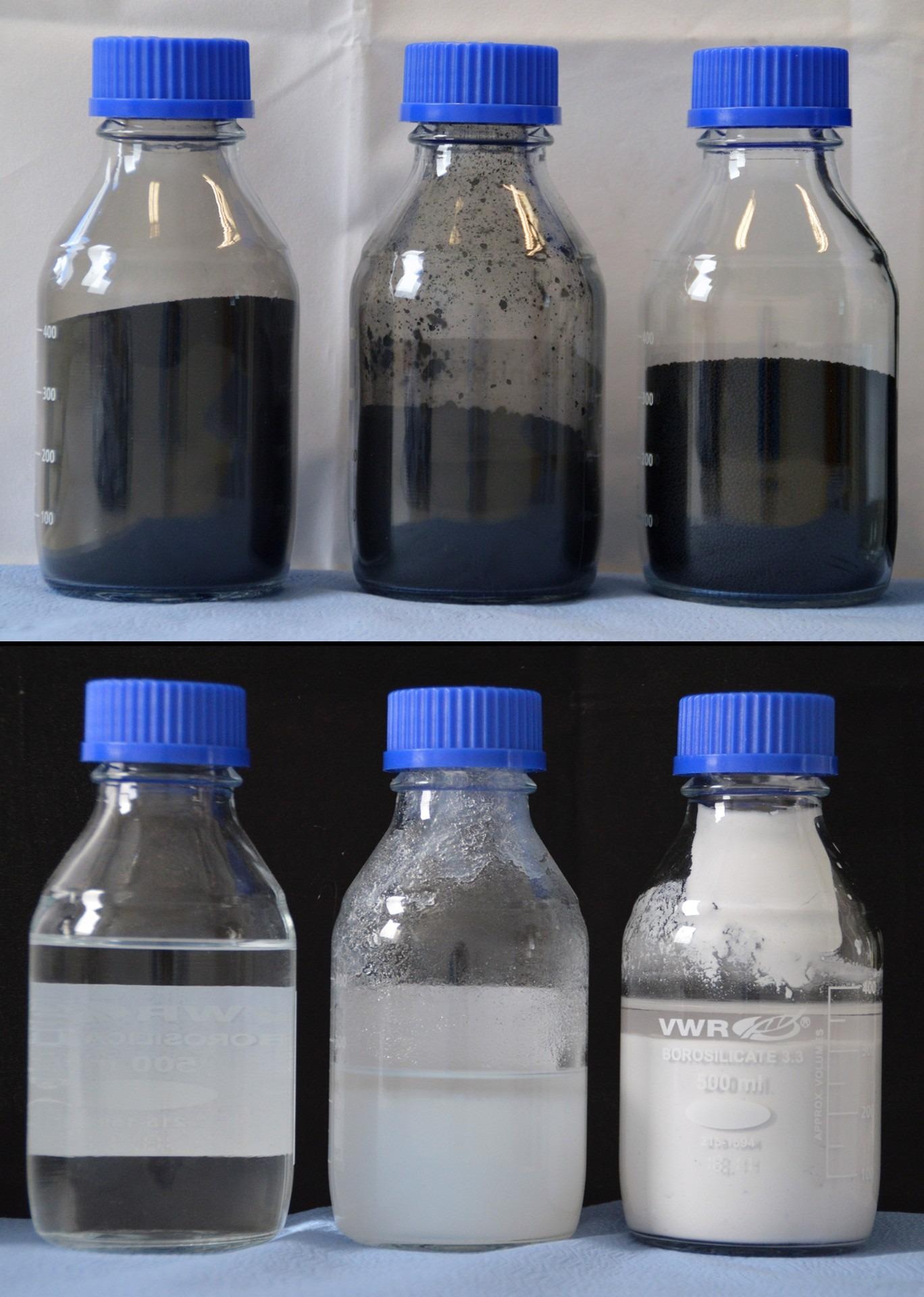Jul 2 2021
So far, waste tires have been primarily utilized for energy sources recovery. Only a sparse proportion of the carbon black included in such tires are recycled, as mineral ash accounts for nearly 20% of its content.
 Top, primary product from left to right: raw rCB, clean rCB (96+), pearlized clean rCB (96+). Bottom, secondary products recovered from the ash, from left to right: liquid sodium silicate or “water glass”, precipitated SiO2, precipitated ZnSO4. Image Credit: Fraunhofer Institute for Building Physics IBP.
Top, primary product from left to right: raw rCB, clean rCB (96+), pearlized clean rCB (96+). Bottom, secondary products recovered from the ash, from left to right: liquid sodium silicate or “water glass”, precipitated SiO2, precipitated ZnSO4. Image Credit: Fraunhofer Institute for Building Physics IBP.
The latest process that has been developed by the Fraunhofer Institute for Building Physics IBP helps isolate nearly all of this ash — enabling both the minerals and the carbon black from the ash to be reused.
Nearly 3 kg of carbon black, which is also called industrial soot, is contained in a standard car tire. The issue is that for one ton of carbon black to be produced, enormous quantities of water and around 1.5 tons of fossil resources are needed. And thus, this process produces up to three tons of carbon dioxide.
It would be sensible to recycle the carbon black contained in end-of-life tires. This is an enormous source of raw material: Nearly four billion end-of-life tires have piled at landfill sites previously, and around another 1.8 billion get added to this pile annually.
So far, people have primarily recovered oils, which are again utilized as an energy source for industrial processes or as a raw material in refineries, from these tires, similar to what is obtained from engineered rubber.
By contrast, the carbon black retrieved during the pyrolysis process remains mostly unused: Mineral ash, containing the additives — mainly zinc components and silicate compounds — is utilized to produce tires and accounts for up to 20% of this carbon black.
Purified Carbon Black from End-of-Life Tires
Led by RCB Nanotechnologies GmbH from Munich, scientists at Fraunhofer IBP in Valley, Germany, have designed a demineralization technique for discharging the recycled carbon black from its mineral load.
The recovered carbon black treated in this way is nearly free of mineral residues, allowing it to be used up to 100 percent for the sidewalls of tires, for example. In other words, there is no need to add any primary carbon black. It can therefore completely replace the original industrial materials.
Dr. Severin Seifert, Group Manager, Fraunhofer Institute for Building Physics IBP
To explain, unless demineralized, only 10% of the recycled carbon black can be added to the main material. The demineralization process not just produces high-grade industrial soot. The minerals are also retrieved with high purity and can be reused for industrial purposes.
However, the question is how researchers purify the carbon black or ash mixture made during the pyrolysis process to the required extent.
By employing a wet chemical method. To put it simply: We place the (raw) carbon black/ash mixture together with various additives in a reactor, blend it with fluid and run a defined pressure and temperature curve. The individual substances are selectively extracted from the mixture.
Christian Kaiser, Project Manager, Fraunhofer Institute for Building Physics
This may sound very easy initially but it is a highly complicated process: The additives and parameters should be set such that only one specific mineral, as homogeneous as possible, is retrieved from the mixture at a time.
Apart from that, pressure and temperature must continue to be at a moderate level to make the process technically viable without any significant limitations. Too many additives should not be used either. It is essential to look out for the economic aspects, and the process cannot turn very costly.
Hence, researchers recuperate a part of the additives, thereby ending the material cycle here as well.
The outcome of the demineralization process is highly pure recycled carbon black that can be used in tires and other rubber products, as well as colorants (master-batch) for plastic applications, silicates, which could be employed in the building materials industry or for dyes, for instance, and also zinc salts for an extensive range of applications.
Industrial Plant Already Under Construction
There is already one pilot plant with a reactor volume of 200 L. It will start working for additional research at Fraunhofer IBP in Valley for the next two years. The goal is to make recovered carbon black useful for other industrial applications as well.
The researchers have already patented the fundamental process, for which RCB Nanotechnologies GmbH is the exclusive licensee.
At present, the company is striving to scale up the process for industrial applications: The production hall has already been built, and it is expected that the reactor volume for one production line will be nearly 4000 L.
This implies that per hour, one production line will discharge 400 kg of recycled carbon black from the ash — which accounts for 2500 tons annually. As part of the final expansion stage, the plant, on the whole, will have a yearly capacity of about 30,000 tons.
For the long term, the plan is to transition from a batch process to a constant process. Prospective stakeholders have already shown their interest.
Our partners are now receiving more requests for samples than we can handle. Ultimately, the recovered carbon black refined in this way is a first credible and sustainable solution for replacing industrial soots.
Christian Kaiser, Project Manager, Fraunhofer Institute for Building Physics